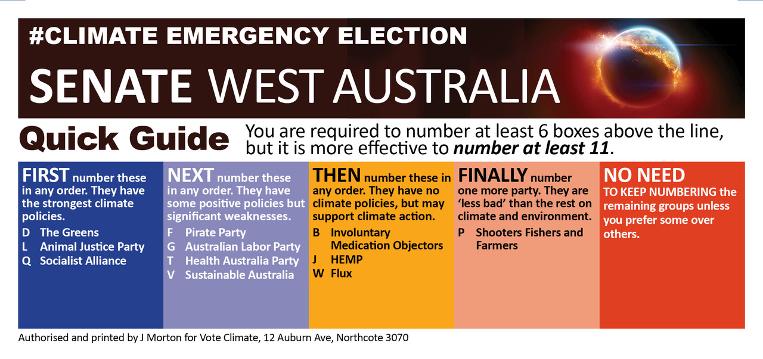Lower house guides
Vote Climate is not doing seat by seat lower house comparisons this election.
There are plenty of scorecards comparing the major parties, For example, the Australian Conservation Foundation scorecard has The Greens rated at 99% for their climate policies, Labor at 56% and the Liberal/National coalition at just 4%. See https://www.acf.org.au/scorecard_2019
In several key electorates there are climate action independents standing local groups have done scorecards. For example, in Josh Frydenberg's electorate, where he is under challenge from Julian Burnside from The Greens and several independents, local group, Kooyong Votes Climate have a produced a handy guide. Margo Kingston at No Fibs has a guide to the independents.
The volunteers at Environment.Vote have done climate how-to-votes for every electorate. A heroic effort! Don't forget to number ALL the boxes on the lower house ballot paper.
In the Senate vote for more than six above the line
Under the new Senate voting system, you must number 6 or more boxes if voting above the line (and 12 or more if voting below the line). That is the minimum legal requirement, but it is far,far better to number as many as possible until you get to the last few that are all as bad as each other.
In each state, there are six seats, so quite commonly two go to Labor, two go to the Coalition and one goes to the Greens. Who wins that sixth seat is quite frequently determined by 100 votes or less, and yet that Senator could end up with the balance of power! If you have just numbered six boxes above the line, and all your preferred candidates have been eliminated by the time the final place is decided, you will have no say over who wins that last place.
Think of it this way: Clive Palmer's United Australia Party could be in contention to win a Senate seat and potentially hold the balance of power. But to do this his party must win the sixth place in at least one state. After all the other parties have been eliminated, his party could be in a final showdown with Labor, or Derryn Hinch's Justice Party or Reason. None of these are great in terms of climate emergency policy, but if you decided not to number Clive Palmer's opponent for the last spot, your vote won't count either way. It's important to number the 'less bad' options as well as the good options.
So tell your friends: 'vote for more than 6'! (Unless, you happen to be in the ACT,and have only nine from which to choose.)
Senate guide Victoria
We have done a detailed guide only for Victoria, but many of the minor parties are the same from state to state, so it can provide some guidance for other states as well.
Here is a quick less detailed Victorian guide for you to take to the polling booth. And a three-to a page version for printing and handing out at polling booths. A more detailed guide is below.
We have done a quick guide to the Queensland Senate. Down load a printable version one to a page (just for you) or three to a page (if you are handing out t a polling booth.)
Our guide is broadly consistent with the senate guide by James Wight from Precarious Climate. His site also contains a wealth of details about the climate and energy policies of the minor parties. One difference is that his rating of Derryn Hinch's Justice Party is harsher than ours. It's true that Hinch's party has no climate and energy policies, but he has consistently voted with Labor on climate and energy policies which makes him considerably better than the parties of the extreme right that preference climate change deniers and are much more of a risk in terms of obstructing emergency action on climate.
The Environment.vote how-to-votes include helpful recommendations for your first six Senate preferences across all electorates, but unfortunately they recommend voting for only six. In Victoria, please keep on numbering till at least 16.
Quick guides for other states
Scroll down this page for quick guides to New South Wales, Queensland, South Australia and Western Australia.
Tasmania, Australian Capital Territory and Northern Territory have a smaller number of candidates standing for the Senate.
For these follow the Environment.vote how-to-votes.
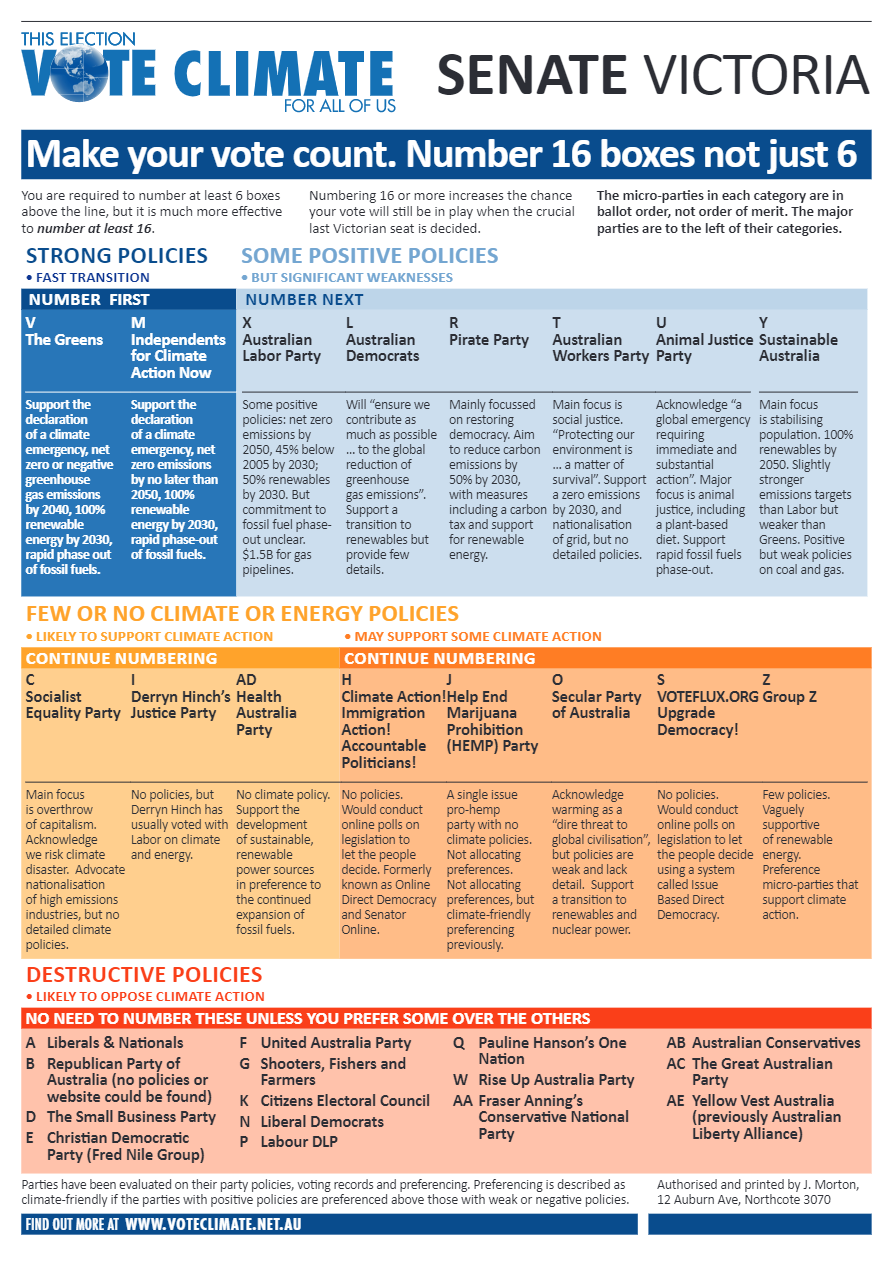
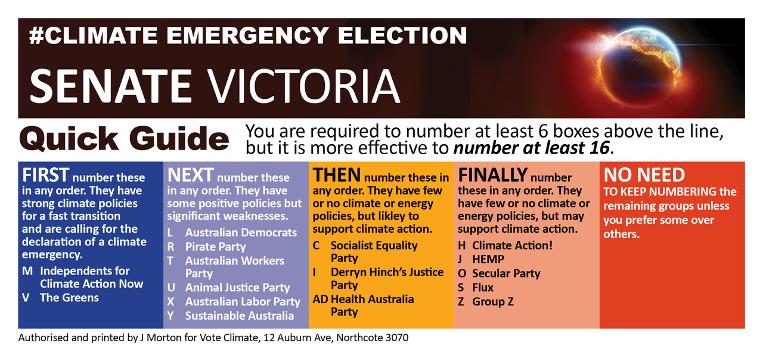
New South Wales
You can download a the quick guide one-to-a-page or three-to-a-page for printing and handing outa t polling booths.
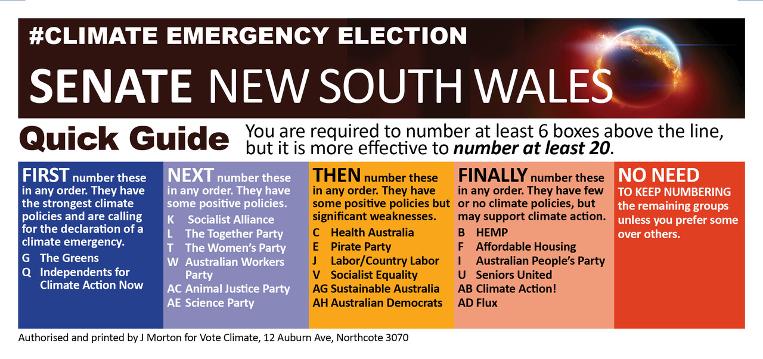
Queensland
Download a one-to-a-page quick guide or print it out three-to-a-page for printing.
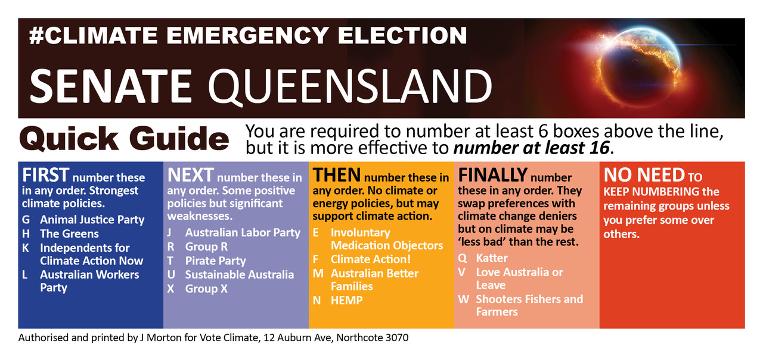
South Australia
Download one-to-a-page or three-to-a-page for printing.
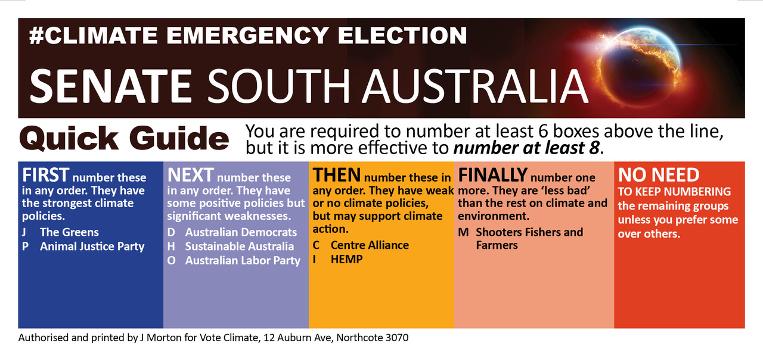
Western Australia
Download one-to-a-page or three-to-a-page for printing.
